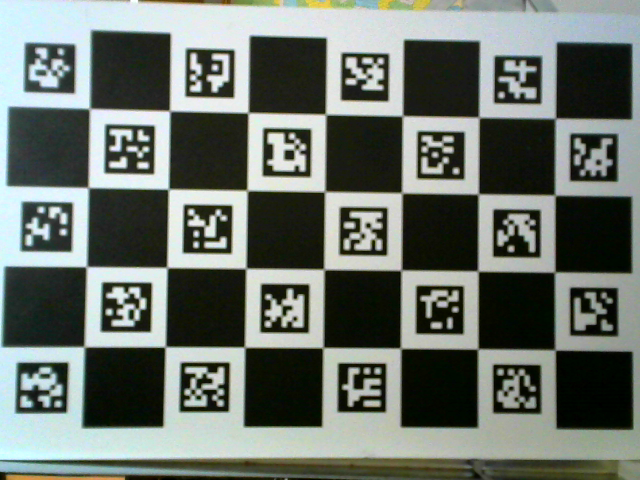Charuco calibration
In calibrateCameraCharuco only interpolated chessboard corners are used, aruco corners are not used Why ?
if you add aruco corner to calibration rms is really bad
import numpy as np
import cv2 as cv
def permutation_taille(pts_aruco):
for ir in range(len(pts_aruco)):
d1, d2, d3 = pts_aruco[ir].shape
pts_aruco[ir] = pts_aruco[ir].reshape((d2, d1, d3))
return pts_aruco
detectorParams = cv.aruco.DetectorParameters_create()
detectorParams.cornerRefinementMethod = cv.aruco.CORNER_REFINE_SUBPIX
detectorParams.cornerRefinementMinAccuracy = 0.01
NBLIGNE = 8
NBCOLONNE = 5
DICO = 14
dico = cv.aruco.Dictionary_get(DICO)
board= cv.aruco.CharucoBoard_create(NBLIGNE, NBCOLONNE, 0.03455, 0.02164, dico)
img = board.draw((1000,1000), 50, 50)
img = cv.imread("imgL.png",cv.IMREAD_GRAYSCALE)
cv.imshow('ChaRuCo', img)
cv.waitKey()
pts_objets = []
pts_camera = []
frame = img.copy()
frame = cv.cvtColor(frame, cv.COLOR_GRAY2BGR)
pts_aruco, ids, refus = cv.aruco.detectMarkers(image=img, dictionary=dico,
parameters=detectorParams)
pts_aruco, ids, refus, recover = cv.aruco.refineDetectedMarkers(
img, board,
pts_aruco, ids,
rejectedCorners=refus)
if recover is not None:
pts_aruco = permutation_taille(pts_aruco)
extract_aruco = True
extract_coin = False
if ids is not None:
retval, coin_charuco, ids_charuco = cv.aruco.interpolateCornersCharuco(
pts_aruco, ids, img, board)
if retval == 0:
print("pb")
exit()
rep_error, cam, dist, rvec, tvec = cv.aruco.calibrateCameraCharuco(
[coin_charuco], [ids_charuco], board, img.shape[0:2],
None, None, None, None, 0)
print("RMS = ", rep_error)
print ("Mat ", cam)
print ("Dist ", dist,)
print ("Pose", rvec, tvec)
cv.aruco.drawDetectedCornersCharuco(
frame, coin_charuco, ids_charuco)
cv.aruco.drawDetectedMarkers(frame, pts_aruco, ids)
pts_reel = None
echiquier = None
if extract_aruco:
for ir in range(len(pts_aruco)):
if echiquier is None:
echiquier = pts_aruco[ir][0]
pts_reel = board.objPoints[ids[ir, 0]]
elif board.ids[ids[ir, 0]]==ids[ir, 0]:
echiquier = np.vstack((echiquier, pts_aruco[ir][0]))
pts_reel = np.vstack((pts_reel, board.objPoints[ids[ir, 0]]))
if extract_coin:
for ir in range(0,ids_charuco.shape[0],3):
index = ids_charuco[ir][0]
if echiquier is None:
echiquier = coin_charuco[ir][0]
pts_reel = board.chessboardCorners[index]
else:
echiquier = np.vstack((echiquier, coin_charuco[ir][0]))
pts_reel = np.vstack((pts_reel, board.chessboardCorners[index]))
pts_reel = pts_reel.reshape((pts_reel.shape[0], 1, 3))
pts_objets.append(pts_reel)
pts_camera.append(echiquier)
else:
print("pb")
exit()
rms, mat_intrin, mat_dist, rvecs, tvecs = \
cv.calibrateCamera(pts_objets, pts_camera, img.shape,
None, None, None, None)
print ("rms ", rms)
print ("Mat ", mat_intrin)
print ("dist ", mat_dist)
print ("Pose", rvecs, tvecs)
cv.imshow("frame",frame)
cv.waitKey()

